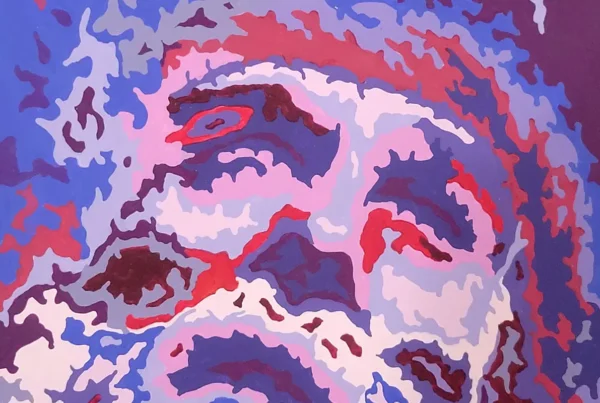Portrait image credit: Gustaf Waesterberg
The Art of Balance: Space and Saturation
Michael Johansson’s artwork captivates with its meticulously structured compositions that push the boundaries of physical space. Johansson’s installations often teeter on the edge of saturation, filling every conceivable corner of a space to its limits. This deliberate overcrowding isn’t just an aesthetic choice but a philosophical exploration of completeness and equilibrium. For Johansson, filling a space to its brim isn’t about closure or finality; it’s about achieving a delicate balance where each object finds its rightful place, creating a sense of calm amidst the clutter. This serene balance, born out of chaos, invites viewers to engage with familiar objects in unfamiliar ways, challenging their perceptions and encouraging them to discover new narratives within the installation.
Johansson’s fascination with space is deeply rooted in his desire to transform the mundane into something extraordinary. By meticulously arranging everyday objects, he elevates the ordinary, making the commonplace remarkable. The process is as much about the objects themselves as it is about the space they occupy. Johansson’s work compels the viewer to consider the relationships between these objects, how they coexist, and how their new contexts alter their original meanings. This transformation is not merely visual; it’s cognitive, prompting viewers to reflect on their surroundings and the often-overlooked items within them.
In Johansson’s work, the balance between an ending and a beginning is blurred. Each installation is a snapshot of a continuous process where objects, once disconnected, are brought together in a harmonious whole. This interplay between order and chaos is central to Johansson’s art, revealing the inherent beauty in organization and the potential for discovery in even the most saturated spaces.

Michael Johansson: The Poetry of Exaggerated Regularity
Johansson’s work often hinges on the concept of “exaggerated regularity,” where seemingly normal situations or objects are pushed to their logical extremes, creating irregularities that captivate and intrigue. A perfect example of this is an experience Johansson recounts, where he stumbled upon a moment of unexpected synchronicity while watching TV at a hotel. Two different channels were playing Bruce Willis movies simultaneously, and as Johansson flipped between them, it seemed as though Willis was interacting with himself across the channels. This coincidence, a convergence of two separate realities, embodies the kind of irregularity that Johansson finds fascinating.
These moments of unexpected connection, where unrelated elements interact in surprising ways, often become subtle yet profound influences on Johansson’s work. His art thrives on these intersections, where the predictable meets the unpredictable, and where regularity is stretched to the point of becoming irregular. This approach imbues his work with a sense of playfulness and improvisation, as Johansson allows these moments of chance to guide his creative process.
In his installations, Johansson often creates systems that appear to loop endlessly, where objects seem to return to their starting points in a continuous cycle. This sense of infinity, where there is no clear beginning or end, echoes the irregularities Johansson is drawn to. It’s a visual and conceptual exploration of how objects and spaces can interact in ways that are both orderly and chaotic, structured yet spontaneous. These qualities make Johansson’s art a unique meditation on the nature of order, regularity, and the unexpected beauty found in their disruption.

Crafting Completeness: Stacking, Layering, and Geometry
Johansson’s installations frequently involve the precise stacking and layering of objects, creating compositions that feel both complete and harmonious. This approach isn’t merely about filling voids or silences; it’s about achieving a perfect balance within a given space. Whether it’s a ladder nested under another ladder or a van packed with meticulously arranged items, Johansson’s work embodies a sense of order that feels both logical and inevitable. The space itself sets the stage, and the objects within it are carefully chosen to create a composition where every element belongs, contributing to a rich, silent dialogue that speaks volumes.
The geometric shapes that dominate Johansson’s work—squares and rectangles—are intentional choices that reinforce this sense of order. These shapes are not only practical, allowing for seamless integration of objects within a space, but they also carry a conceptual weight. Squares and rectangles evoke a sense of minimalism and logic, aligning perfectly with Johansson’s desire to create works that are both orderly and meaningful. These geometric forms serve as a framework within which Johansson can explore the relationships between objects, ensuring that each piece feels coherent and complete.
Johansson’s focus on creating systems where objects loop back on themselves reflects his broader interest in the idea of infinite cycles. This concept is not just a formal choice but a reflection of Johansson’s fascination with the continuous interplay of objects and spaces. By imposing strict order on these elements, Johansson highlights the tension between control and chaos, inviting viewers to explore the delicate balance that underpins his work. In doing so, he offers a commentary on our own tendencies to seek order in a chaotic world, revealing the beauty that can emerge when we succeed.

Michael Johansson: The Evolution of Objects and Time
Time and consumerism are recurring themes in Johansson’s work, particularly as they relate to the found objects that populate his installations. These objects, often sourced from flea markets and thrift stores, come with their own histories and layers of meaning. Johansson is deeply interested in how these histories can be re-contextualized, transforming objects from their original purposes into new, imaginative forms. By doing so, Johansson not only breathes new life into these objects but also encourages viewers to reconsider their own relationships with the things they surround themselves with.
The passage of time is a critical element in Johansson’s creative process. He often spends long periods collecting objects before beginning the assembly of a piece, allowing time to influence both the selection of items and their final arrangement. This approach speaks to Johansson’s belief that time is not just a practical consideration but an integral part of the creative process. It’s through this careful management of time that Johansson is able to bring together disparate elements into a cohesive whole, ensuring that each piece feels complete and harmonious.
Looking ahead, Johansson envisions his work continuing to explore these themes of time, consumerism, and the evolving nature of objects. As our relationship with consumption changes and new technologies emerge, Johansson is curious about how these shifts will influence his art. He sees potential in the intersection of the physical and digital worlds, where objects and spaces might be reimagined in entirely new contexts. Through this ongoing exploration, Johansson aims to challenge both himself and his audience, offering new perspectives on the familiar and the forgotten, and continuing to push the boundaries of what art can be.






